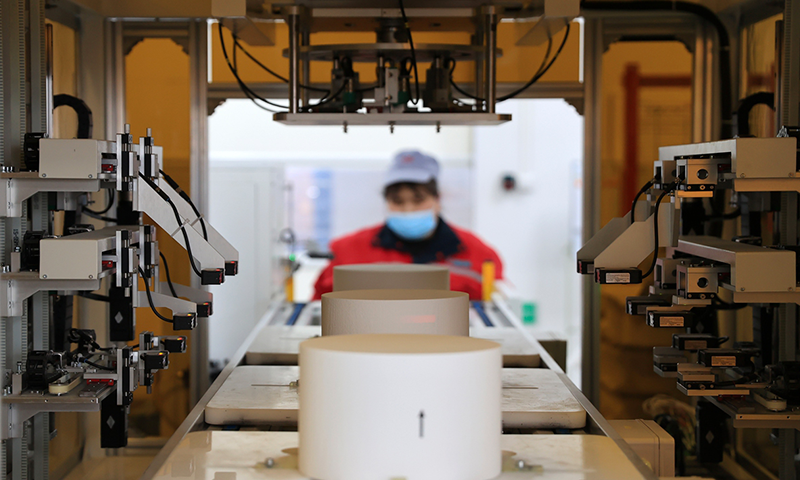China's August industrial profit sees strong rebound as recovery accelerates amid stimulus

China's major industrial firms saw their profit surge in August, reversing the downward trend and increasing by 17.2 percent from a year earlier, the latest sign of sustained recovery in the world's second-largest economy as stimulus kicks in.
The robust industry growth, which marks the first increase since the second half of 2022, may pave the way for a full rebound as a slew of economic indicators are also pointing to a positive consumption trend during the upcoming Golden Week holidays, observers said.
With consumption and manufacturing activities all in full swing, the domestic economy is expected to ride on the fast track of stabilizing growth, though challenges remain, they noted.
In the first eight months of the year, the profits of major industrial firms with annual main business revenue of at least 20 million yuan ($2.79 million) reached 4.66 trillion yuan, down 11.7 percent year-on-year, with the pace of decline narrowing by 3.8 percentage points from the first seven months, according to data released on Wednesday by the National Bureau of Statistics (NBS).
Of the 41 industrial categories monitored by the bureau, 30 posted better performance in terms of profit during the January-August period, with the losses in raw material manufacturing industry narrowing significantly due to rising commodity prices and recovered demand.
As the country's pro-growth policies continued to show their impact in August, industrial production saw a steady recovery, with the improvement in industrial profit gathering momentum, said NBS statistician Yu Weining.
Profit growth for equipment manufacturing was 3.6 percent for the period, growing from the 1.7 percent registered during the first seven months and leading the overall improvement, Yu said, noting that all business entities recorded better performance.
The reversal in August, reflecting that the overall operating conditions of the industrial sector are improving, was mainly driven by the rebound in market demand, improved prices of industrial products, the effects of macro-support policies, and the low base in 2022, Zhou Maohua, an economist at Everbright Bank, told the Global Times on Wednesday.
The rebound was in line with the momentum of China's official manufacturing purchasing managers' index (PMI) for August, which came in at 49.7, up 0.4 points from the previous month.
A reading below 50 indicates a contraction, while one above 50 indicates expansion.
"The recovery of the PMI represents stable market confidence and projection, and enterprises' profit recovery is the real consequence, which shows that the general situation is improving," Cong Yi, professor at the Tianjin University of Finance and Economics, told the Global Times on Wednesday.
All multiple indicators are upbeat signs for the country's overall economic recovery, and also reflect that a series of supportive measures have taken effect, Cong said.
Notably, in the first eight months of 2023, profit of the electricity, heat generation and supply industry surged by 53.4 percent year-on-year, and profits for electrical machinery and equipment manufacturing increased by 33 percent year-on-year. In addition, profit of auto manufacturing increased by 2.4 percent year-on-year.
NBS data also showed that profit of enterprises in the metal, mineral processing, and energy extraction sectors suffered a decrease, while the profits of coal extraction and washing enterprises declined by 26.3 percent year-on-year, and the profit of chemical raw material and production manufacturing enterprises declined by 51.1 percent.
Structural adjustment of China's industrial enterprises growth is ongoing, and it's a vital period now for shifting the country's economic drive force from traditional industry to emerging sectors, Cong said.
Nevertheless, some domestic industrial manufacturing industries are still in the destocking stage, Zhou said, noting that problems such as insufficient market demand and high cost pressures still pose difficulties for company operations.
"Domestic macro policy support cannot be relaxed," Zhou said.
Chinese authorities have stressed stronger and more precise measures to bolster the recovery over the past months. In a fresh move on Wednesday, China's central bank said at a quarterly meeting that it would step up policy adjustments and implement monetary policies to expand domestic demand and restore confidence.
During the meeting, the bank emphasized the need to intensify the implementation of existing monetary policies, enhance counter-cyclical and cross-cyclical adjustments, and focus on boosting domestic demand and restoring confidence.
In light of the current domestic and international economic situation, the bank noted that "the current external environment has become more complex and challenging," with inflation remaining high and developed countries expected to maintain elevated interest rates. Additionally, it acknowledged that "the domestic economy continues to recover and improve with strengthened momentum, but still faces challenges such as insufficient demand."
Globally, downward pressure on the world economy has been intensifying.
According to a Reuters report citing an S&P Global survey, business activity in the US, the world's largest economy, showed little change in September, with the vast services sector essentially idling at the slowest pace since February, and overall new order activity slipping to the lowest level in 2023.